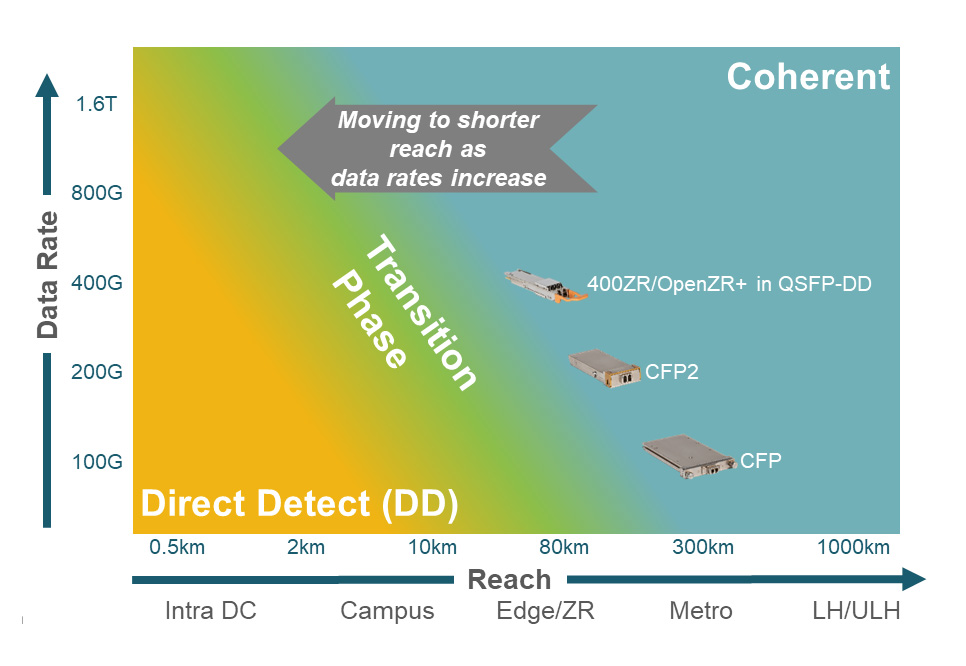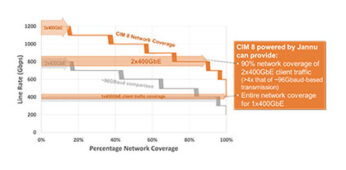Over the years, we have referred to the trend shown in Figure 1 as Acacia’s view of how coherent technology would be adopted for shorter reaches as the challenge for meeting the bandwidth demand for those applications increases. With the successful market introduction of 400ZR coherent pluggable transceivers for edge data center interconnect (DCI) applications, we are on the threshold of using coherent solutions for campus and intra-data center (DC) applications for 800G and beyond.
At OFC 2022, there were several presenters discussing a new effort dubbed “coherent lite.” Roughly speaking, this term is used to convey a simplified implementation of coherent transmission for use in short reach campus and intra-DC applications. Compared to traditional transport DWDM applications, coherent lite removes unneeded features such as laser tunability and reduces complexity of impairment mitigation features such as dispersion compensation. Compared to alternative 800G and beyond solutions, coherent lite offers higher speed per wavelength, lower laser or fiber count, and better receiver sensitivity. By leveraging the continued trends of CMOS, the key components to build coherent-lite modules in a pluggable format are on par with alternative solutions with regards to power and size. The additional link budget available with a coherent implementation can be utilized to optimize the design for cost and power. These reasons make coherent lite a compelling solution for pluggable 800G and beyond in campus and intra-DC applications.

Figure 1. Coherent solutions moving to shorter reaches as application data rates increase; pluggable modules leading the charge towards shorter reaches.
Coherent lite has been proposed for 800G campus network applications in both IEEE and the Optical Internetworking Forum (OIF), while some in the industry are already talking about coherent interfaces inside the data center at 1.6 Tbps. The OIF was the first to take action in this space, kicking off the 800LR project in late 2020 to pursue a solution for unamplified reaches of 2-10km using fixed wavelength coherent transmission. Hyperscale network operators are expected to be the first to adopt this technology due to their high bandwidth campus and intra-DC interconnect requirements. And as bandwidth demands increase to 1.6 Tbps intra-DC links, coherent lite solutions are expected to competitively address sub-2km reaches inside the data center.
Intra-Data Center Optical Interconnect Requirements
12.8Tbps Ethernet switches required 400G pluggable modules in QSFP-DD and OSFP form factors. 400ZR coherent optical transceivers, supporting these form factors, were developed for DCI edge network applications up to 120 km in reach. With switch capacity increasing to 25.6 Tbps, followed by 51.2 Tbps, optical transceivers are expected to migrate from 400 Gbps to 800 Gbps and then towards 1.6 Tbps speeds. Scaling the optical interconnect solutions to match these increasing port speeds can be challenging. While legacy-based intensity-modulated-direct-detect (IM-DD) solutions may continue to have a role for shorter intra-DC links at 800G, longer reach intra-DC applications benefit from coherent solutions. And at 1.6Tbps port speeds, coherent can become the preferred solution even for short intra-DC links.
Besides supporting growing port speeds, intra-DC optical interconnects at 800G and beyond are required to have low power consumption, high density, and support of high-volume deployments. To meet these requirements, modules can leverage advancements in low-power CMOS technology (which follows Moore’s Law), silicon photonics, and innovative packaging and integration solutions.
Another key intra-DC requirement is interoperability, which helps to drive broad industry adoption and higher volumes, thereby lowering supply chain risks for network operators. The importance of a robust supply chain has never been more important, and the higher volumes required for intra-DC applications make interoperability critical for coherent-lite adoption.
Coherent solutions have already proven capable of meeting these data center requirements of low power, high volume, and interoperability at 400G with the successful introduction of 400ZR modules. Coherent lite solutions are anticipated to chart a similar path for 800G and beyond.
Coherent Solutions for Intra-DC Applications
400G coherent pluggable transceiver solutions have proven that high-density, low-power coherent technology tailored to inter-data center switch/router interconnection applications are achievable. The industry has now embarked on a similar effort to bring to market cost-effective, high-volume coherent solutions optimized for campus and intra-DC applications.
Traditional intra-DC optical interconnects utilize IM-DD transmit/receive technology. Generational increases in link speed have required parallelization of fibers (e.g. 400G-DR4 using four fibers) or wavelengths (e.g., FR4 CWDM), as well advanced amplitude modulation schemes such as PAM4. While this aggregate approach has been successful to date, chromatic dispersion (CD) impairments begin to impact performance as the link speed requirement increases. Due to the square relationship between CD tolerance and the modulation baud rate, as you double each wavelength’s baud rate the CD tolerance is reduced by a factor of four. Alternatively, increasing the number of wavelengths pushes outer channels further from the fiber zero dispersion point resulting in having to mitigate this entire wavelength range to meet the link budget. Thus, even though the intra-DC distances are short, traditional IM-DD methods of increasing link capacity are expected to encounter challenges as intra-DC applications move to 800G and beyond.

Figure 2. IM-DD and Coherent proposed solutions to address 800LR applications.
Figure 2a illustrates a traditional IM-DD approach to address intra-DC and campus applications over a single-mode fiber pair, which for the 800G case multiple WDM lasers would be utilized to ensure sufficient link budget at this data rate.
IM-DD solutions are expected to be utilized for 800G intra-DC application reaches in the 2km range, while coherent technology would support 800G from 2km to 10km reaches. For optical platforms such as silicon photonics where a single laser’s power can be shared across multiple fibers, we expect the IM-DD solutions to remain attractive in those short, parallel fiber applications.
Coherent Lite Offers Cost-Optimized, Low Power Solution
In comparison to the IM-DD implementation, a coherent solution (Figure 2b) addressing the same 800LR link would achieve the target link budgets using one laser, and the improved sensitivity that is achieved using coherent detection. The laser capacity can be increased four-fold by utilizing the phase and polarization dimensions of light (I/Q modulation and polarization multiplexing). Using a single laser compared to four can result in cost and power improvements. In addition, the DSP in the coherent solution can mitigate dispersion effects as it would in a traditional transport solution but with a simpler implementation for a 2 to 10km reach.
Since intra-DC architectures do not need dense wavelength transmission in fiber, grey (fixed wavelength) lasers can be used, which greatly simplifies the design and reduces module cost. Also, the extra available link budget due to higher receiver sensitivity can be used to lower the required laser power to reduce module power dissipation. In addition, coherent technology for high-capacity transport has traditionally required higher supplier capital expenditures on a per unit basis because of lower volume, more expensive test equipment required for the stringent specification requirements that drive the need for more comprehensive test coverage. Coherent lite intra-DC modules would be tested more like IM-DD client optics, resulting in substantial reduction in manufacturing capex with higher capacity.
These are some of the compelling reasons why the industry is looking toward coherent technology for shorter connections at 800G and beyond. Coherent lite 800LR pluggables can provide a competitive cost structure, while meeting campus and intra-DC requirements. This makes these solutions clear candidates for applications typically addressed by IM-DD solutions.
Opening the Doors to Coherent
400G coherent pluggable solutions have driven the momentum towards interoperable, high-volume solutions that are enabling coherent in campus and intra-DC applications at higher data rates, especially when utilizing a cost and power optimized coherent implementation. Compared to IM-DD, coherent offers a scalable path towards higher intra-DC data rates with more capacity per laser wavelength, higher receiver sensitivity, and digital equalization of impairments. In addition, the coherent lite solution may offer less technical risk and earlier market availability.
As requirements move beyond 800G towards 1.6T for intra-DC connections, dispersion impairments and link budget requirements are expected to be even more challenging for IM-DD solutions. Because of this, coherent-lite solutions are expected to be a strong contender for high-volume 1.6T intra-DC interconnect applications.


